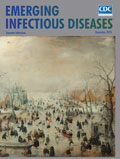
Volume 24, Number 12—December 2018
Etymologia
Etymologia: Capnocytophaga canimorsus

Figure. Paul de Vos, Cats Fighting in a Larder 1630–1640. Oil on canvas. Museo Nacional del Prado. https://www.museodelprado.es/coleccion/galeria-on-line/galeria-on-line/obra/pelea-de-gatos-en-una-despensa/, Public Domain, https://commons.wikimedia.org/w/index.php?curid=39117357
From the Greek kapnos (“smoke”) for its dependence on carbon dioxide, which is a large component of smoke, Capnocytophaga canimorsus (Latin canis, “dog,” and morsus, “bite”) are gram-negative, facultatively anaerobic, rod-shaped bacteria that are part of the normal oral microbiota of dogs and cats (Figure). The genus was proposed to distinguish these bacteria from Cytophaga spp. (Greek kytos, “cell,” and phagein, “eat”), which also exhibit gliding motility. C. canimorsus was previously known as CDC group DF-2 (dysgonic fermenter type 2) and was first isolated from a man who had experienced multiple dog bites and developed septicemia and meningitis. C. canimorsus remains a major cause of septicemia in persons, particularly those who are asplenic or immunocompromised, who are bitten by dogs or cats.
References
- Brenner DJ, Hollis DG, Fanning GR, Weaver RE. Capnocytophaga canimorsus sp. nov. (formerly CDC group DF-2), a cause of septicemia following dog bite, and C. cynodegmi sp. nov., a cause of localized wound infection following dog bite. J Clin Microbiol. 1989;27:231–5.PubMed
Figure
Cite This ArticleOriginal Publication Date: 10/30/2018






















.png)











No hay comentarios:
Publicar un comentario